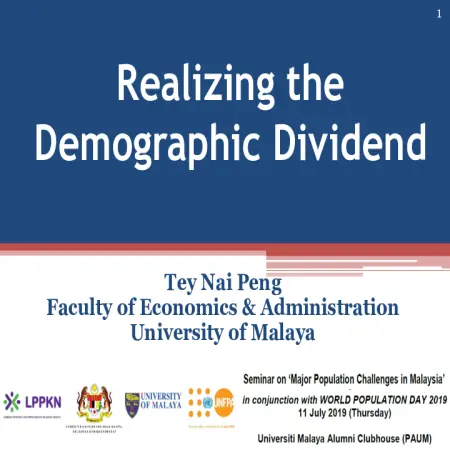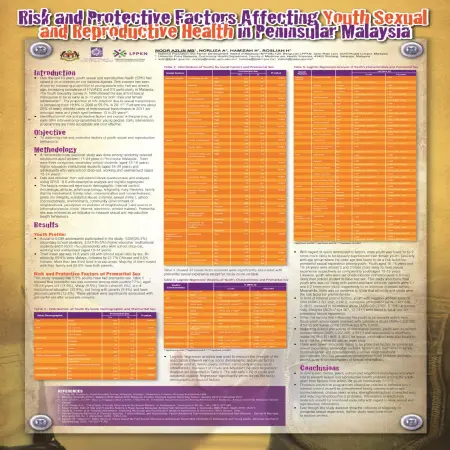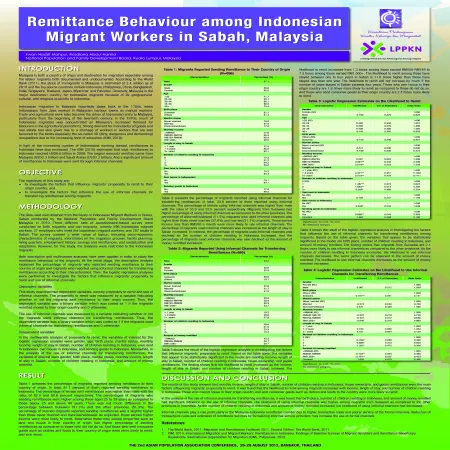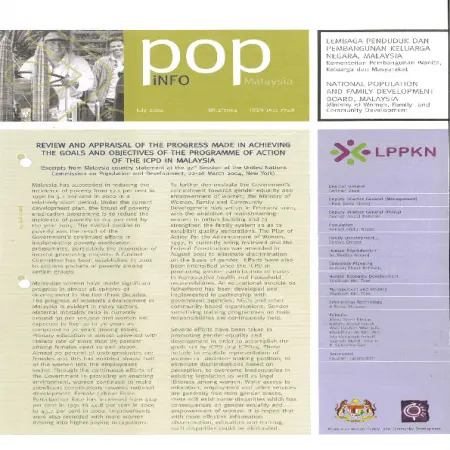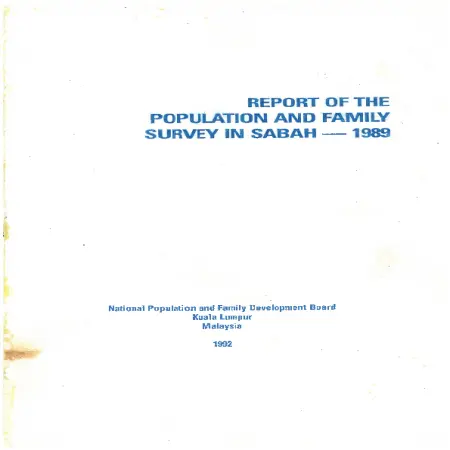Advanced Search
2024 (1)
2023 (1)
|
|
Review on big data analytics in population research: methods and application
Item Type: Book Section
Editor:
Year: 00/12/2023
Abstract: This exploration delves into the transformative influence of big data analytics on population research, encompassing methodologies, tools, applications, challenges, and their chronological distribution. It scrutinizes the digital era's impact on the field and the emergence of novel data sources and techniques. Key research papers contributing to this discourse are also highlighted.
|
|
|
|
2022 (3)
|
|
Reka bentuk aplikasi saringan mental sihat remaja
Item Type: Book Section
Editor:
Year: 10/11/2022
Abstract: Mental health is one of the most important aspects that must be met by every individual to achieve optimal health in addition to physical and social well-being. An increase in mental health-related problems can be seen every year and puts pressure on the daily life of patients among teenagers who are more susceptible to mental disorder factors due to the influence of the environment and current lifestyle, coupled with the situation of movement control orders (MCO) throughout Malaysia. However, many individuals do not undergo screening due to feeling of shame and are unware of their problems.
|
|
|
|
|
|
Redefining quality interpersonal communication in marriage from divorcees’ perspectives
Item Type: Book Section
Editor:
Year: 00/00/2022
Abstract: Quality interpersonal communication is essential in the development and maintenance of any relationship, including marriage. As society adapts to new avenues of communication, married couples often underestimate the relevance of interpersonal communication in their relationship due to their lack of understanding of quality interpersonal communication. Therefore, this study investigated the conceptualisation of quality interpersonal communication through the lens of Relational Dialectic Theory in marriage from the perspectives of divorcees.
|
|
|
|
|
|
Relationship between family functioning, resilience and psychological well-being among B40 youths in the Klang Valley district
Item Type: Book Section
Editor:
Year: 00/00/2022
Abstract: Global economic uncertainties in the COVID-19 era have had an adverse impact on many households across nations, including Malaysian households. In particular, the B40 households have seen an upsurge in the cost of living, which puts a strain on their purchasing power. The Malaysian government has implemented various initiatives to alleviate the financial burdens of the B40 groups, such as Bantuan Prihatin Malaysia. Yet, the psychological wellbeing of the B40 group’s families are not under care.
|
|
|
|
2021 (1)
|
|
Regulating retirement village in Malaysia; the way forward
Item Type: Article
Editor:
Year: 00/12/2021
Abstract: As Malaysia is predicted to be an ageing nation by the year 2030, developing a retirement village shall be an avenue for senior citizens to have a welfare and conducive placement for them to spend their time with value-added amenities that cater their special needs. This paper discusses the overview concept and elements of retirement village sector in Malaysia and other jurisdictions, and the possibility of having a sustainable legal framework in regulating the sector. The legal issues and possible unintended consequences that may arise out of the development of retirement village in Malaysia is also discussed in this paper.
|
|
|
|
2020 (1)
|
|
Report on Malaysia Family Well-Being Index 2019
Item Type: Research Report
Editor:
Year: 00/00/2020
Abstract: The Family Well -Being Index (FWI) is a multi -dimensional benchmark specially developed to measure the level of family well -being in Malaysia. This index is generated through a mother’s or father’s assessment of their family’s well -being. The 2019 Malaysian Family Well -Being Index score recorded in this study is 7.72 out of a maximum scale of 10. Of the eight domains that have been identified, the Family Relationship Domain recorded the highest domain score of 8.35. This is followed The study also found that the 2019 FWI score is increasing according to household income group. The 2019 FWI score is higher in families living in rural areas. In terms of family type, FWI 2019 scores were higher in family groups by Family Domain, Role of Religion and Spiritual Practice (8.25), Family Domain and Community Involvement (8.00), Family Safety Domain (7.86), Family Economics Domain (7.67), Family Health Domain (7.44), Housing and Environment Domain (7.35) and Family and Communication Technology Domain (6.82). Although the score of FWI 2019 is still at a moderate level but it has shown an increase of 0.39 points compared to 7.33 for FWI 2016.
|
|
|
|
2019 (1)
|
|
Realising the demographic dividend
Item Type: Conference or Workshop Item
Editor:
Year: 00/00/2019
Abstract: Malaysia has done well in harnessing the demographic dividend through pragmatic planning and management, and investment in health and education. It is ranked among the very high Human Development index country (from 63 to 57). Achieved almost all the goals of ICPD (1994-2014) and MDGs (2000-2015).
|
|
|
|
2018 (1)
|
|
Relationship between family functioning, parenting behaviour, self-efficacy, and gender on risky behaviour amongst adolescents in Kuala Lumpur, Malaysia
Item Type: Thesis
Editor:
Year: 00/00/2018
Abstract: Adolescence is the developmental period marked by a rise in risk-taking behaviours. The high rate of adolescents’ involvement in risky behaviours in the past decades has created a vast amount of attention on the impact to their future. In Malaysia, the impact of risky behaviour has been alarming as evidenced by the media reports on baby dumping, unwanted pregnancies, drug addiction and juvenile delinquency. The increasing trend of adolescents’ involvement in risky behaviour may be associated with social- and self-factors. The current study was conducted to investigate the relationship between family functioning, parenting behaviours, self-efficacy, and gender on risky behaviours amongst adolescents in Kuala Lumpur, Malaysia. This quantitative study utilised a descriptive and correlational research design. Data were collected using self-administered questionnaires. A total of 411 adolescents aged 15 to 18 years were recruited as respondents. Six instruments were used namely the Family Perception Scale, the Parental Monitoring Scale, the General SelfEfficacy Scale, the Adolescent Alcohol and Drug Involvement Scale, the Adolescent Sexual Activity Index, and the Self-Reported Delinquent-Problem Behaviour Frequency Scale to measure the respective variables. Descriptive, bivariate, and multivariate statistics were used in analyses to address the specific objectives of the study. The study found that 12.6% of adolescents reported engagement in substance use, 47.2% in risky sexual behaviour, and 52.1% in delinquency. The independent t-test analysis showed that the proportion of male adolescents who engaged in substance use was higher compared to female. There were no significant differences between male and female in risky sexual behaviour and delinquency. Findings of this study showed that self-efficacy only moderated the relationship between parental monitoring and substance use, whereby the effect is strongest among adolescents with low self-efficacy, and weakest among adolescents with high self-efficacy. This suggested that there is low risky for adolescents to involve in substance use if the adolescent has higher level of self-efficacy. Meanwhile, gender only moderated the relationship between parental monitoring and risky sexual behaviour, whereby the effect is stronger among male adolescents compared to female adolescents. This suggested that male adolescents tend to involve more with risky sexual behaviour compared to female adolescents. The present study conclude that family functioning (family cohesion, communication), parenting behaviour (parental monitoring and parental involvement), self-efficacy and gender influence risky behaviours (substance use, risky sexual behaviour and delinquency) amongst adolescents in Kuala Lumpur. The findings has implication for parents as well as individuals and professional working with adolescents. Parental monitoring was significantly correlated with substance use thus parents were suggested to provide appropriate monitoring to increase awareness that their involvement is crucial in reducing adolescents’ substance use. They also need to be equipped with appropriate skills to establish high quality relationship with their adolescent children. The finding also call for intervention to provide adolescents with necessary skills to help them avoid being involved in risky behaviour.
|
|
|
|
2017 (2)
|
|
Reproductive and social health education
Item Type: Book Section
Editor:
Year: 01/01/2017
Abstract: On 6th December 2009, the Cabinet approved the PEKERTI Policy & Action Plan proposed by Ministry of Women, Family and Community Development (MWFCD), which aims to guide young people from getting involved in social problems.
|
|
|
|
|
|
Report on Malaysian Family Well-Being Index 2016
Item Type: Research Report
Editor:
Year: 00/00/2017
Abstract: The NPFDB (2011) defined family well-being as a safe, healthy, comfortable, harmonious and satisfying family condition. This definition covers various aspects, such as spiritual satisfaction and comfort in respect of their economy and finance; mental, psychosocial, and health; political: and sustainability. Family Well-Being Index (FWBI) 2016 measured the level of family well-being through a household's assessment by the father or mother regarding the well-being of their families. This index examined the level of well-being in terms of family relationships, family economy, family relationships, family economy, family health, family safety, family and community involvement, religious and spiritual practices, housing and the environment, and family and communications technologies in the country. The overall FWBI 2016 score was 7.33 out of a maximum score of 10.
|
|
|
|
2016 (2)
|
|
Report on key findings Fifth Malaysian Population and Family survey (MPFS-5) 2014
Item Type: Research Report
Editor:
Year: 01/12/2016
Abstract: The 2014 Malaysian Population and Family Survey is the fifth in a series of surveys conducted by the NPFDB every 10 years since 1974. This fifth survey was funded by the Economic Planning Unit of the Prime Minister’s Department under the 10th Malaysia Plan allocation. In conducting the survey, the NPFDB received tremendous cooperation and support from various agencies at federal and state levels as well as from nongovernmental organisations. The purpose of this survey was to collect the latest information and time series data in respect of demography, family and reproductive health of the Malaysian population. It also aimed to update the indicators obtained based on the previous surveys in the series. The MPFS-5 provides specific information on the population, household, family formation, fertility, family planning, family life, health practices, elderly as well as the social and sexual behaviours of the adolescents. It also collected the latest information on career and family balance, well-being, breastfeeding, secondary infertility, financial management, intergenerational assistance and the use of social media.
|
|
|
|
|
|
Research on risk and protective factors affecting adolescents' sexual and reproductive health in Sabah & Sarawak 2015
Item Type: Research Report
Editor:
Year: 09/09/2016
Abstract: A quarter of the world population (1.8 billion) consists of people aged 10-24 years (UN DESA, 2009). Adolescents is a phase of life whereby they have opportunities for developing healthy behaviours, which can determine the future pattern of adulth health. However, for most adolescents, this is the phase of self-discovery whereby they undergo biological, psychological, social and economic changes in their life. Curiosity and experimentation are normal among them where certain behaviours would place adolescents at risk of undesired consequences of their activity.
There are various biological, social, educational and psychological risk factors that predispose adolescents to unhealthy and unsafe sexual phenomena such as premarital sex, having multiple sexual partners, unwanted pregnancy, early childbearing and illegal abortion. In terms of biological factors, early menarche, being male men and older age were found to be the significant risk factors. In addition, social factors including unemployment, peer influence (peer/ friends who have had sexual experience) and use of the substance such as alcohol, tend to increase the tendency of unsafe and unhealthy sexual practices (WHO, 2004). Besides, lack of sexual reproductive health information and skills in negotiating sexual relationship, inaccessibility of youth-friendly SRH services are other risk factors that had been identified (Low, 2006).
Although there is limited data on teenage pregnancy in Malaysia, the increasing reports on incidences of abandoned babies indicate that increased premarital sexual intercourse resulted in unwanted pregnancies among unmarried adolescents. From 2005 to March 2014, it was reported that there were 561 cases of baby dumping (RMP, 2014; Mansoor, 2014). the number of reports of abortion indicates that there is an increase in the number of extramarital sex among unmarried adolescents. Many 51 cases of infant abandonment were reported in 2005 to March 2014 (PDRM, 2014; Mansoor, 2014).
In 2012, a study was conducted to identify the risk and protective factors of adolescents in Peninsular Malaysia (NPFDB, 2015). There has been a dearth of studies on adolescents’ SRH in Sabah and Sarawak. Therefore, studies on SRH among this sub-population are warranted. Furthermore, there are differences in terms of demographic characteristics compared to Peninsular Malaysia. Based on these findings, more specific educational and intervention programmes tailored to the needs of the adolescents in Sabah and Sarawak need to be planned and implemented in order to prevent them from engaging in risky sexual behaviours. The objective of this study was to determine the risk and protective factors related to sexual and reproductive health (SRH) of adolescents in Sabah and Sarawak.
|
|
|
|
2015 (1)
|
|
Realizing the future we want: integrating population issues into sustainable development
Item Type: Newsletter
Editor:
Year: 00/00/2015
Abstract: Malaysia is closely monitoring the developments and discussion on the post-2015 development agenda. Malaysia believes that the post-2015 development agenda should integrate existing international commitments and outcomes of UN conferences and deliver on equality, social inclusion, decent work, and sustainable livelihoods.
|
|
|
|
2014 (2)
|
|
Risk and protective factors affecting youth sexual and reproductive health in Peninsular Malaysia
Item Type: Scientific Poster
Editor:
Year: 00/01/2014
Abstract: Over the last 10 years, youth sexual and reproductive health (SRH) had raised a lot of concern on the national agenda. This concern has been driven by increasing proportion of young people who had sex at early age, increasing prevalence of HIV/AIDS and STI particularly in Malaysia.
|
|
|
|
|
|
Risk and protective factors affecting adolescent youth sexual and reproductive health in Peninsular Malaysia
Item Type: Conference or Workshop Item
Editor:
Year: 00/00/2014
Abstract: This study shows that over the last 10 years, youth sexual and reproductive health (SRH) had raised a lot of concern on the national agenda. According to the statistics, age at first sexual intercourse to be as early as 9-10 years for both male and female adolescents (The Youth Sexuality Survey, 1996). The proportion of HIV infection due to sexual transmission is increasing from 18.8 % in 2000 to 55.5 % in 2011. About 26 % of newly infected cases of heterosexual transmission in 2011 are among teens and youth aged between 13 to 29 years. This study is to determine the prevalence of SRH behaviours of adolescent/youth and to identify risk and protective factors that influence adolescent/youth sexual reproductive health in Peninsular Malaysia.
|
|
|
|
2012 (2)
|
|
Remittance behaviour among Indonesian migrant workers in Sabah, Malaysia
Item Type: Scientific Poster
Editor:
Year: 00/08/2012
Abstract: Malaysia is both a country of origin and destination for migration especially among the labour migrants both documented and undocumented. According to The World Bank's Migration and Remittances Factbook 2011, the stock of immigrants in Malaysia is estimated at 2.4 million as at 2010 and the top source countries include Indonesia, Philippines, China, Bangladesh, India, Singapore, Thailand, Japan, Myanmar, and Pakistan. Generally, Malaysia is the major destination country for Indonesian migrants because of its geographical, cultural, and religous proximity to Indonesia.
The objective of this study is to investigate remittance behaviour among Indonesian migrants including the decision to remit and use of informal methods of transferring remittance. The data used was obtained from the Study of Indonesian Migrant Workers in Tawau, Sabah conducted by the National Population and Family Development Board Malaysia in 2010. Three different sets of questionnaire-based survey were conducted on both migrants and non-migrants, namely 896 Indonesian migrant workers, 37 employers who hired the Indonesian migrant workers, and 787 locals in Sabah. Both descriptive and multivariate analyses have been applied in order to study the remittance behaviour of the migrants. At the initial stage, the descriptive analysis explained the percentage of migrants who send remittance and migrants who use informal channels according to their characteristics. Then, logistic regression analysis was performed to investigate the factors that influence migrants' decision to send remittance and the use of informal methods of transferring remittance. The results of this study showed that age, monthly income, number of children residing in Indonesia, having own house in Indonesia and sending goods to Indonesia are the main factors contributing to the migrants' decision to remit. It was found that the likelihood to remit among migrants increased with age, income and number of children residing in Indonesia. Those who own house in their origin country and sending goods to the country are more likely to remit. In the analysis of methods of transferring remittance, it was found that birth place, number of children residing in Indonesia and the total amount of money remitted have significant relationship with the use of informal channels. The likelihood of using informal channels is higher among migrants from Sulawesi as compared to the other parts of Indonesia. As the number of children residing in Indonesia and amount of money remitted increased, the likelihood of using informal channels had decreased.
|
|
|
|
|
|
Retirement planning: Dynamic and holistic approach in bridging the gaps and mitigating the risks
Item Type: Conference or Workshop Item
Editor:
Year: 00/00/2012
Abstract: Most of us will one day row old and frail. Some will be fortunate enough to be endowed with wealth and good health in retirement years. But others in fact many of us, some call it the 99% group, will not be so fortune. We may have wealth but not health. We may be healthy but not wealthy. Many will probably have enough income to put food and drink on the table, and roof over the head, but will there be enough to cover unexpected expenses? Can we depend on our children to financially and/or physically take care of us in our golden years? They too will likely be facing similar problems such as soaring costs of housing, children’s education, lifestyle upgrading, busy schedule and others making it less likely that we can depend on them for assistance. This paper discusses the needs as we age, identifies gaps that may occur and suggests the best ways for us to share and meet needs as individuals and as a nation. Retirement planning is dynamic and holistic. We are not just planning to build up wealth and good health, we must also plan to protect our wealth and health. When planning for retirement, all risks that we might face must be understood at the outset and strategies to mitigate them must be worked out.
|
|
|
|
2009 (1)
|
|
Resilient families coping with sudden demise husband: an exploratory and empirical study of 50 nuclear urban middle class families in North India
Item Type: Conference or Workshop Item
Editor:
Year: 00/00/2009
Abstract: The paper offers research based Resilient Indian Family Template' culled from the coping practices adopted by 50 Nuclear Urban Middle Class Families in North India in the eventuality of sudden loss of husband. Convenient random sampling technique of data collection was employed for choosing the 50 families in question. Further interview and narrative methodology was used to elicit information from the families. Sudden loss of husband was accompanied by emotional and health problems for the surviving spouse, acute feeling of loneliness, decreased standard of living for the family, increased moral support from close relatives, children especially grown ups showing more restraint and responsibility in their habits and one member (in most cases it was wife) taking up income generating activity. Coping practices adopted by these families helped them rebound from crisis.
|
|
|
|
2006 (1)
|
|
Recent changes in Korean families: demographic, social and cultural perspective
Item Type: Conference or Workshop Item
Editor:
Year: 00/00/2006
Abstract: This paper deals with recent changes in Korean families from diverse perspectives. Demographic conditions affecting family structure and family life in contemporary Korean society can be characterized as lowest-low fertility and speeding aging. Fertility in Korea drastically dropped to 1.08 of total fertility rate in 2005, one of the lowest records in the world. On the other hand, as a result of lowering fertility in part, aging has been proceeding too rapidly to adapt to new social environment. If aging continues with the current speed, it is easily predicted that Korean people will face financially unprecedented burden to support elderly within a short time. Lowest-low fertility and rapid aging have been clearly observed since the 1997 economic crisis in Korean society. In my view, Korean society has become an absolutely different society from that before the economic crisis. Not only social structure but also individual attitudes and behaviors and familial life had to be under restructuration right after the economic crisis. Thus, the economic crisis has to be regarded as a critical factor in recent family changes in Korea. Educational attainment for female has been expanded and comparable works for women have been increased. Thus, women had to have difficulties in finding marriageable men after the economic crisis. This has led to increasing age at first birth for both men and women, in other word delay marriage and family formation. Korean family has shown several new features in the late 1990s and early 2000s. One is the decreasing family formation. Another is increasing remarriage in Korea. Remarriage, in particular women's remarriage was negatively stigmatized according to a Confucian legacy to prohibit women's remarriage in traditional times. This custom has been remained for a long time. However, increasing divorce not only at younger ages but at middle and older ages has widened the possibility of remarriage for both men and women. Tolerance toward remarriage at the societal level has also greatly increased according to various family surveys. Even first-time marriage by men has been made with divorced or bereaved women. Another feature in contemporary marriage in Korea is a soaring international or interracial marriage, especially for Korean men. Single men in rural area have had so many difficulties in finding marriage partner because Korean women would not like to marry farmers or men residing in rural area. Under the shortage of marriageable women, rural men began to seek foreign bride, firstly from China and then Vietnam these day. Thus, more than one to ten marriages are now an interracial marriage in Korea. Changing demographic and familial conditions results in small size of family in Korea. The average number of household members is now less than three. On the other hand, one-person household is remarkably increasing in both urban and rural areas because of increasing divorce, deepening aging and increasing number of the female bereaved, and wide pursuit of independent life by younger generation. Also, with this trend, the proportion of female head of household is steadily increasing. However, female household heads are more suffering from poverty than male counterparts because of sex-discriminatory labor market, lack of women-friendly welfare policy and dual burden by the traditional patriarchal family system.
|
|
|
|
2004 (1)
|
|
Review and appraisal of the progress made in achieving the goals and objectives of the programme of action of the ICPD in Malaysia
Item Type: Newsletter
Editor:
Year: 00/07/2004
Abstract: The role of the civil society organisations and non-government organisations as partners in the implementation of population programmes has been recognised and supported in Malaysia. Their involvement, participation, sharing resources and consultation have been pivotal to the sucess of the population related programmes.Since ICPD, annual dialogues between Government and NGOs have been conducted to facilitate greater smart partnership. Recognizing their role, grants are made available by the Government to NGOs to enable them to play more effective role in grassroot programmes and activities.
|
|
|
|
2002 (1)
|
|
Reproductive health: special reference to HIV/AIDS
Item Type: Newsletter
Editor:
Year: 00/07/2002
Abstract: The HIV/AIDS situation is recognised as a public health problem in Malaysia and one that is of a national concern especially with regard to the spread of HIV / AIDS among young people and to newborns through mother-to-child transmission. Since the first case of AIDS was reported in Disember 1986, there has been a geometric increase in the number of HIV infections. Over the last seven years (1995-2001), the average number of new cases reported annually was 4,716. By 2001, the cumulative number of HIV infections was 44,208 with 1,258 cases of AIDS and 934 deaths.
|
|
|
|
1992 (3)
|
|
Report of the Malaysian Family Life Survey-II 1988
Item Type: Research Report
Editor:
Year: 00/00/1992
Abstract: MFLS-2 was, in part, a follow-up to the original Malaysian Family Life Survey, fielded in 1976-1977, reinterviewing original respondents and their adult children, plus interviewing a new group of women age 18-49 in 1988. The information that is collected are household-level retrospective and current data from women and their husbands, covering such topics as fertility, nuptiality, migration, mortality, employment, household composition, transfers, and income as well as social, economic, and community-level factors affecting family decision making. MFLS-2 added a sample of older Malaysians to support research on their living standards, health, and intergenerational transfers.
|
|
|
|
|
|
Report of the Population and Family Survey in Sarawak - 1989
Item Type: Research Report
Editor:
Year: 00/00/1992
Abstract: The main objective of the Population and Family Survey in Sarawak was to provide necessary data for the formulation, implementation and evaluation of population and family development programmes, in line with national objectives. Specifically, the survey was conducted to collect information on socio-cultural determinants of fertility and maternity patterns, fertility preferences and behaviour, female labour force participation, childcare arrangement, family life, family planning practices, socio-economic status of subgroups, as well as population profiles and migratory patterns.
|
|
|
|
|
|
Report of The Population and Family Survey in Sabah - 1989
Item Type: Research Report
Editor:
Year: 00/00/1992
Abstract: The main objective of the survey was to provide necessary data for the formulation, implementation and evaluation of population and family development programmes, in line with national objectives. Specifically, the survey was conducted to collect information on socio-cultural determinants of fertility and maternity patterns, fertility preferences and behaviour, female labour force participation, childcare arrangement, family life, family planning practices, socio-economic status of subgroups, as well as population profiles and migration patterns.
|
|
|
|












